While most of the maritime satellite internet connection packages are only limited by their maximum throughput some ISPs offer services with high bandwidth at suprisingly low cost. These packages can however include an extensive Fair Access Policy (FAP) or Fair Use Policy (FUP) and will impose a maximum limit on the amount of data you can transfer in a certain period of time.
Our question is how Fair is Fair, and is this the right option for you?
Why do Satellite ISPs need Fair Access/Usage Policies?
When ISPs have nearly unlimited bandwidth (like most Cable or DSL ISPs) they don’t need to impose rigourous fair access policies because there is plenty of it for all subscribers. However, satellite ISPs do not have unlimited bandwidth and due to the cost of a satellite connection being expensive packages with volume based fair access policies are offerred at a cost substantially lower than their unlimited counterparts.
While these packages seem attractive at first it is important to take a closer look at what is actually being offerred and whether in the end this would result in your advantage.
Most FAP/FUP packages will allow you to use a certain bandwidth/speed until you have reached a certain volume of data. Once the initial threshold is reached the speed is reduced until you reach the next threshold after which the speeds will be reduced some more.
Gone in 60 hours…
The problem with this kind of configuration is that if you do not have rigourous control over how your bandwidth is being used (e.g. everyone can access the internet without limitation) then you will most likely run out of high bandwidth very quickly.
When you are just a few crew members on board it could be feasible to monitor your bandwidth and agree not to abuse it. On vessels with larger crews (10 is already difficult to manage manually) it is very likely that the total available bandwidth will be used very quickly, internet radio and streaming video will if not controlled take up everything they can get.
Fast, Faster, Fastest
An additional problem can be the unreallistic bandwidth to data volume threshold ratio. This problem occurs when the maximum initial bandwidth is so high in comparison to its volume thresholds that it will reach those limits very quickly and speed will then be reduced to a fraction of the initially advertised high bandwidth.
The higher the initial speed, the quicker you will reach the preset limit and the quicker you will be limited in speed, usually much to the frustration of everyone on board.
But I have a bandwidth managing router …
… is frequently heard, but more often than not the device’s bandwidth policies (for users and/or applications) can not take into account the threshold set by the Fair Use Policy. Adjusting policies on how much bandwidth can be used by certain user groups, users and application when a threshold is reached and bandwidth is reduced is rarely available.
On most routers, if maximum bandwidth management is configured at all, it will be set to the initial highest throughput, and try to distribute traffic based on that initial setting. It will most of the time be set to its maximum bandwidth even though thresholds have been reached and use the same distribution policy as when it had full capacity.
How badly will you be throttled and when?
That depends on how your ISP has set its limits. If the limits set allow you to reach a fair amount of data before being throttled then it can be justified. But the question remains: what is fair? A 1Mbps link can generate 10.5 GB of traffic in a day., and roughly 300 GB in a month. If you want to use your speed comfortable and your data allowance is e.g 30GB then you can quickly estimate that afer 3-4 days (maybe a little more is you are careful, you will have hit the threshold.
Below is an example of a link that offers a 4Mbps downlink, its thresholds are set as follows:
maximum 4096 Kbps up to 25 GB
maximum 1024 Kbps up to 30 GB
maximum 256 Kbps up to 35 GB
maximum 128 Kbps up to 60 GB
maximum 64 Kbps over 60 GB
While at first glance this would seem like a good solution (it’s unlimited volume !!!) let’s look at the data in more detail. Based on our experience we know that a ship in operation with a decent size crew will easily use 75% of its bandwidth (averages taken over 6 months).
In this case (avg 75% of maximum bandwidth) the availability of highest speed (4096 Kbps) within a month would be:
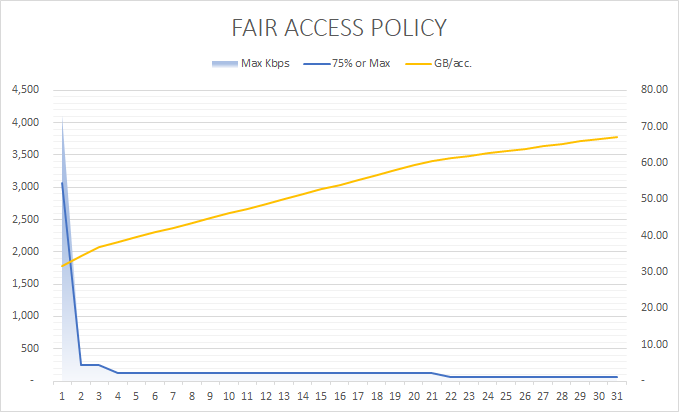
daily average speed: 3072Kbps
As you can see from the graph above the accrued data volume (orange line, in GB) would reach the first threshold on day 2 and by day 4 you would only have 128 Kbps left of the original 4096 Kbps
Maybe your vessel is not so data-hungry and they can settle with using no more than 25% of the the maximum bandwidth on an average day. The results would look like this:
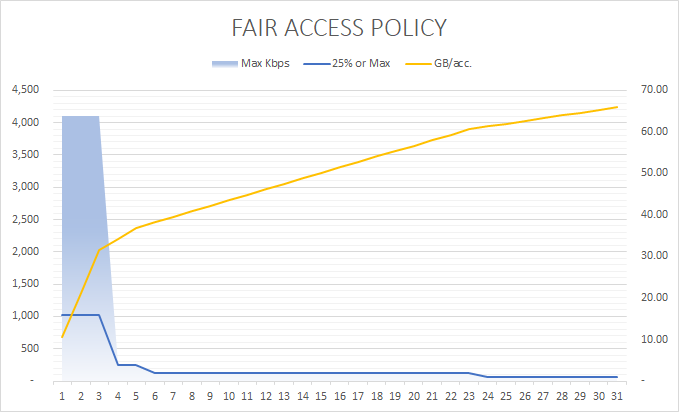
daily average speed: 1024Kbps
Even though only 1mbps average per day is being used, the first threshold is already reached on the 4th day, and by day 6 again only 128 Kbps is left (which is 32 times less than maximum speed).
Let’s assume that you have the best and most disciplined crew and they will never use more that 12.5% of the maximum available bandwidth, never to exceed 512 Kbps download.
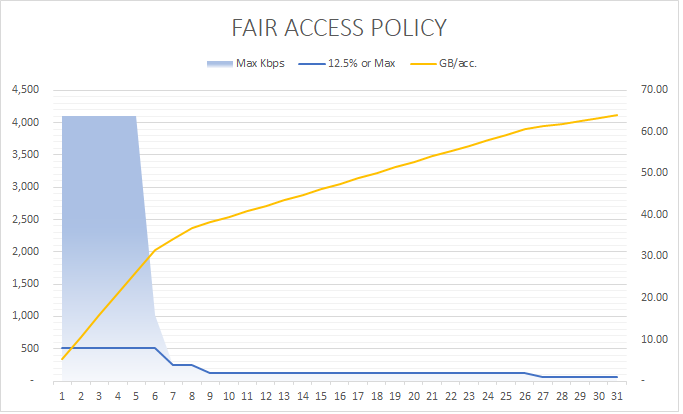
FAP used at 12.5% of maximum
daily average speed: 512Kbps
Again by day 7 high speed will not be available anymore and by day 9 the highest achievable burst would be only 128 Kbps.
If we would like to have the possibility until the end of the month to achieve a high speed (4096 Kbps) burst the daily average bandwidth usage should in this case not exceed more than 1.5625 % of the maximum bandwidth or 64 Kbps.
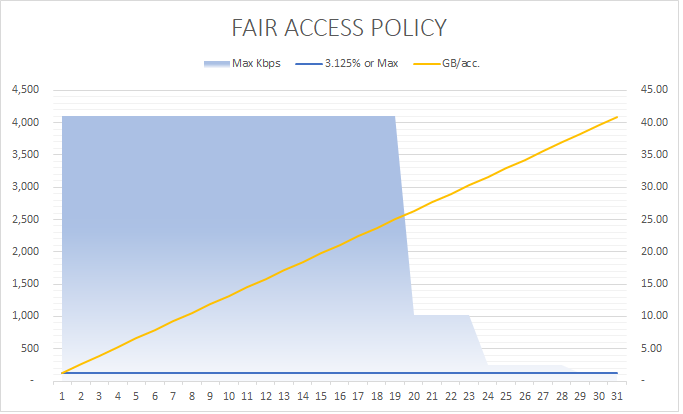
FAP used at 3% of maximum
daily average speed: 128Kbps
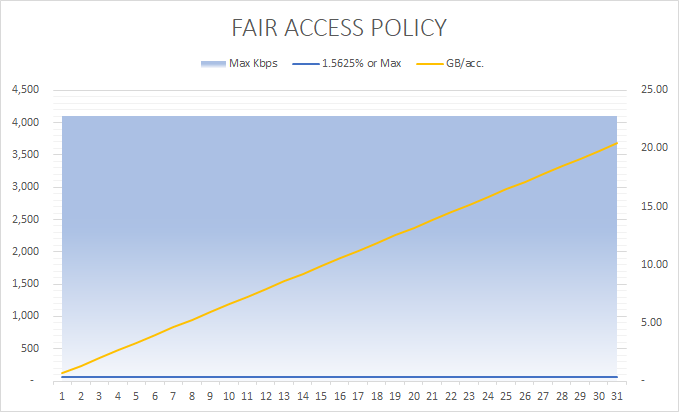
FAP used at 1.5625% of maximum
daily average speed: 64Kbps
While high bandwidth capability might be advertised, and there is nothing wrong with that, the amount of data volume thresholds need to be proportionate. If not, you will quickly be using very limited bandwidth with all the unpleasant consequences.
The Alternative
While the above tends to dazzle us with their apparently very high speed for a relatively low cost we have taken that same cost and seen what can be achieved in a more traditional speed based setup without FAP. In this case we found a 1024 Kbps 1:8 service for the same cost as the FAP service above and checked what would be the result.
As there is no threshold the maximum speed will not be limited by volume. It is however a contended service so the link is shared with (in this case) 7 other terminals. If none of them are using the link you will have the possibility to achieve 1024 Kbps, when all terminals are using the link at the same time you will have a maximum throughput of 128 Kbps. In most cases the maximum speed usually will be around 60-70% of the MIR.
With average of 512 Kbps minimum (green) and 1024Kbps maximum (blue) :
- the available bandwidth will be spread more or less equally over the whole period.
- you will achieve higher average speed.
- the amount of data that you will be able to transfer will be much higher.
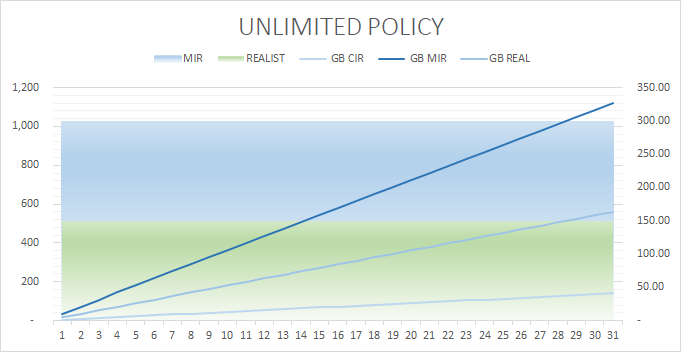
The GB volume lines indicate traffic accumulation at resp 128 Kbps (GB CIR), 1024 Kbps (GB MIR) and 512 (GB REAL). And while if you so are unlucky that you are stuck at CIR (128Kbps) you will only be able to transfer 41 GB, it is more likely that you will be able to transfer between 150 and 200 GB or maybe even more
Conclusion
While FAP services seem attractive (and some might work for you) they might not work for everyone. Bear in mind that there are always several options and calculate your cost per actual GB.
If you have received a FAP proposal and you would like to have a detailed Bandwidth report on what is actually being offerred then send us an email to [email protected]
